If you’re looking for a versatile, easy-to-use grill and smoker, you need to seriously consider a pellet smoker.
While you won’t win any points with old-fashioned pitmasters, the ability to produce excellent barbecue without fussing over a fire makes buying a pellet smoker very tempting.
In this guide, we review the best pellet smokers available at various price points, from big box store brands to American-made competition quality pits.
The Best Pellet Grills You Can Buy in 2024 Reviewed
These are the five best pellet grills out of over 30 we have tested. Unlike a lot of other websites out there, our team has cooked on all of these pits. We’ve put them through rigorous tests to see how well they perform at smoking and grilling.
We’ve looked at size, features, and budget to help shortlist the best grill for people with different needs. These are all full-sized pellet grills, so if you plan on tailgating, check out our guide to the best portable pellet grills.
1. Best Overall – Weber Searwood 600
Read our full Weber Searwood 600 review.
We were highly critical of Weber‘s first attempt at a pellet grill. The original SmokeFire suffered from questionable design choices that led to pellet jams and grease fires. Subsequent versions did get better, and the Stealth edition eventually made this list.
The new Searwood is replacing the SmokeFire. It’s a complete redesign, and after putting this grill through two months of rigiorus testing we can confidently say Weber has knocked it out of the park.
The new Searwood lineup includes the Searwood 600, which is the model we’ve tested, and comes with 648 square inches of grilling space. If you need more room the Searwood XL 600 gives you 972 square inches.
Unlike most pellet grills, you can actually grill over the entire cooking surface and get great sear marks. We’ve made a YouTube that gets into a lot more detail.
You can also swap the grill grates out for an entire flat top griddle surface or add a rotisserie. Both options are sold as optional accessories, so you can easily add that functionality down the road.
What we like:
- Edge-to-edge sear – While you do get some hotter and cooler zones, as long as you rotate your meat, you can use the entire surface for high heat grilling.
- Versatile add-on options – Add a rotisserie or swap out the grill grates for a griddle surface
- Great controller – This grill heats up quickly and gets back up to temperature faster after you open the lid. You can even run it with the lid open for grilling.
- Adjustable smoke setting – A standard feature on more expensive pellet grills, so it’s nice to see Weber include.
- Grease and ash clean up – Easy system for managing grease and ash so you don’t have to pull the grill apart to clean nearly as often
What we don’t like:
- Front and side shelves are sold separately – You don’t get much prep space without spending money on these accessories. Straight out of the Traeger playbook.
- Grill grate choice – I preferred the grates on my SmokeFire stealth for searing, although the Searwood still does OK.
For only a small price jump, the Searwood is better in almost every way than the popular Traeger Pro, and is an easy recommendation for anyone with a budget of under $1,000.
2. Best Mid-Range – Camp Chef Woodwind Pro
Read our full Camp Chef Woodwind Pro review.
The original Camp Chef Woodwind has been one of our most recommended pellet grills.
The Pro takes everything we liked about the original and improves on it with more rugged construction, and our favorite feature, the new built-in Smoke Box. For only $200 more, we think it’s a no-brainer to go for the Pro vs the standard Woodwind.
Unless you want to do a lot of grilling, the Woodwind Pro is also a better choice than the Weber Searwood, although it’s very close.
For years we’ve complained about pellet grills lacking the depth of wood flavor you get from more authentic smokers, so it’s great to see manufacturers come up with new solutions.
The Woodwind Pro is available in two sizes. Most people will choose the mid-sized 24″ model, which gives you 811 total square inches of cooking space (429 sq in the lower rack + 382 sq in the upper rack.
If you need to cook for a crowd, you can opt for the otherwise identical 36″ model, which gives you 1236 square inches of grill real estate to use.
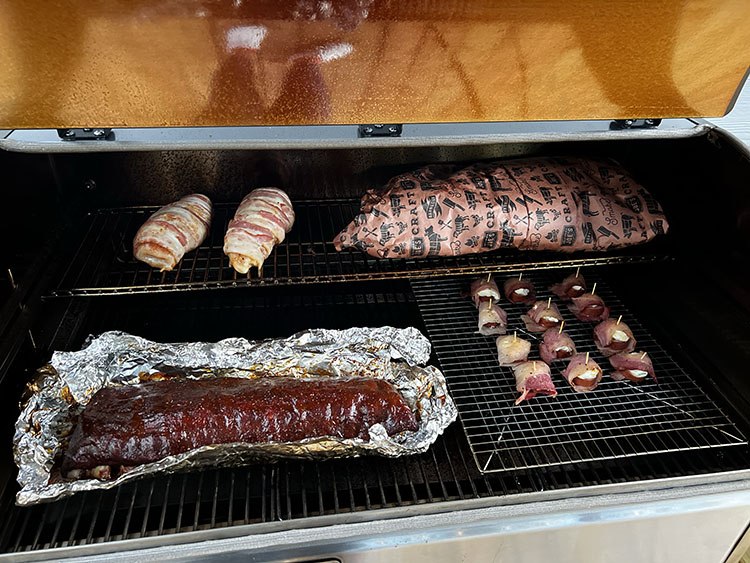
The Woodwind ticks all the boxes you expect from a pellet grill at this mid-price point. You’ll enjoy the set-it-and-forget-it style barbecue with the four color-coordinated meat probes included, helping you keep an eye on your temperatures.
You can control the grill via a large color touch screen or via the companion App. One of the best features in the app is the option to ramp up or down smoke output by setting the “Smoke Number”.
If you crave even more smoke flavor, the new smoke box is a great addition. Accessed via a handle below the lid, the smoke box can hold a few chunks of wood or charcoal.
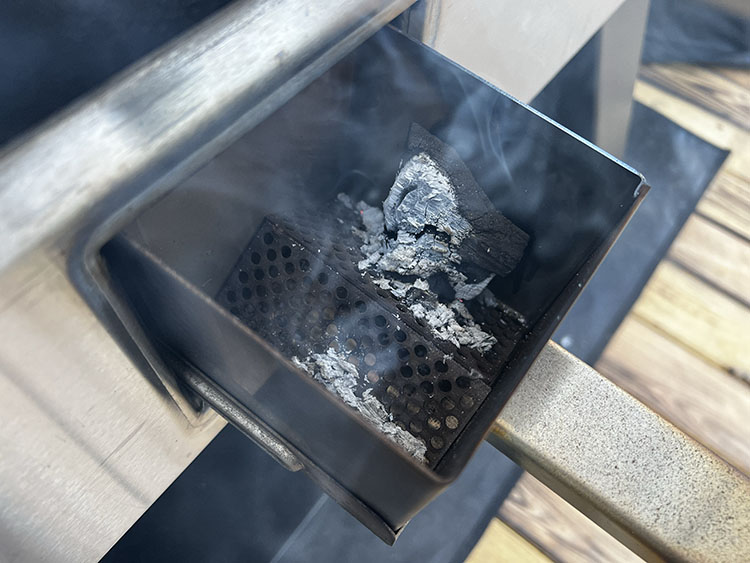
The burning pellets ignite the fuel, so all you have to do is reload.
The other major drawback with most pellet grills is their inability to sear.
Camp Chef gives you the option to upgrade to the SickKick and convert the side table into either a flat top or a sear station.
You can buy the Woodwind Pro packaged with either the Searbox or Flat Top, or upgrade in the future.
What we like:
- Super simple to operate – From the digital controls that allow you to dial in the exact temp you want to the ash cleanout system, the Woodwind Pro is one of the easiest-to-operate pellet grills we’ve tested.
- Smoke Box – The option to add more authentic smoke flavor by burning lump charcoal or wood chunks is a game changer for pellet grills.
- SideKick attachment – Add a powerful propane burner that can be configured as a flat top griddle or sear box to give you ultimate versatility.
- Smoke adjustment controls – You can set the smoke level between 1-10 depending on if you want subtle or heavy smokey flavor.
What we don’t like:
- No cabinet door – You get a small storage shelf, but it would be more useful if there was a door so you could keep a bag of pellets or some tools dry.
- Smoke Box Size – I could only fit 2 to 3 chunks of wood or lump charcoal at once, so I wish they had made it a little bigger.
3. Best Budget Pellet Grill – Z GRILLS Backyard Warrior 7002C2E
If both the Weber and Camp Chef are outside your budget, then the 7002C2E (AKA Backyard Warrior) from Z Grills is our pick for the best budget pellet grill.
With 697 square inches of cooking space, you also end up with slightly more grill real estate than the Weber, and Z Grills include a free cover.
It’s always tough recommending a budget pellet grill. Because there is so much technology involved, there’s more that can break (or never work correctly).
When we first got our hands on a Z Grill, they were a fairly new brand on the scene. Now they have been around for a while, and we’ve seen their models go through several upgrades and continue to get better.
You now get a PID temperature controller, which keeps your temperature a lot more stable. There’s also a larger screen, two probes included, and an easy pellet clean-out feature.
In 2024, they’ve also added WiFi so you can control the grill on your phone.
If you want to save even more, you could consider a smaller model like the 450B (reviewed here), or if you can stretch your budget the Z Grills 700D4E also comes with Wifi and a better cart.
What we like:
- Value for money – Getting a pellet grill with this much cooking space for the price is already a good deal. Throw in solid stainless steel construction, a newly updated PID digital temperature and pellet control system and the Z-grill starts to look like a steal.
- Stable temperatures – In our tests, this grill barely swings by more than 5°F, far lower than many more expensive grills we have tested
- Pellet dump system – If you want to change pellet flavors or remove unused pellets after cooking, there is a handy door at the back of the hopper that makes clean out a breeze.
What we don’t like:
- Lid handle placement – You must be careful when closing the lid so that you don’t touch the hot surface. Might not be a problem for you, but at 5ft 10″, I had to be careful not to burn my hand.
4. Best High-End Pellet Smoker – Yoder Smokers YS640S Pellet Grill
Read our full Yoder YS640S review.
Once you get up to this price point you are spoiled for choice with a wealth of great options from the likes of REC TEC, and the Traeger Timberline.
But if you talk to any competition guy, the one brand that always comes up is Yoder.
So what does spending three times the cost of our top pick the Traeger Pro get you?
For starters, this is the only pellet smoker on our list that is American-made (in Kansas).
This grill is built like a tank with 10-gauge steel construction for unparalleled insulation and temperature stability across 1070 square inches of cooking space.
You can also switch between indirect heat and direct, over the flame grilling to hit temperatures up to 700°F.
There is Wi-Fi and Bluetooth connectivity plus two integrated food probes for keeping an eye on your food while it smokes.
What we like?
- American made – Everyone says they want American made, so here’s your chance to put your money where your mouth is.
- Extra headroom – The door design allows 12 inches of headroom which is enough for extra tall items like beer can chicken, or turkey.
- Customization options – Just like buying a car, you can option out your Yoder with various extras, including different types of cooking grates, griddle, temperature gauge, and shelves.
What we don’t like?
- Price – You’re going to have to pay a lot for local construction and high-end build quality.
If you have the money to spare, the YS640s is an excellent investment. It’s far from the most expensive pellet grill, but anything above this you start to get diminishing returns.
Other pellet grills worth considering
These are the pellet grills that narrowly missed out on our main selections.
They are still worth checking out, and depending on your specific requirements, they might be the best option for you.
6. Feature-packed but expensive – Traeger Timberline
Read our full Traeger Timberline review.
The Traeger Timberline ticks many boxes because it’s well-built and packed with useful tech.
Traeger has the best app out of any pellet grill manufacturer, plus you get access to 1600+ recipes in the Traeger app.
The Timberline is a big step up in quality and features (and price) from the Pro. Besides the larger size, you get better-insulated construction, more prep and storage areas, a pellet sensor, super smoke mode, and an induction plate.
You can choose between Timberline and the Timberline XL, which come with 880 and 1320 square inches of cooking space. There are no significant differences besides the amount of grill space and a price hike.
What we like:
- Packed with tech – The market-leading app makes it easy to control your grill via your phone. The Pellet sensor gives you alerts when pellets are running low, so you don’t run the risk of running out mid-cook.
- Clever design – The Timberline is packed with quality-of-life features including ample prep areas, a hopper cleanout trapdoor that makes it easy to empty unused pellets after a cook.
What we don’t like:
- Small wheels for the size – For a grill of this size and price it would be nicer to have larger wheels with an easier-to-access locking mechanism.
- The price – A lot of folks will have trouble spending this much money on a Traeger, when there are American-made options for less
The Traeger Timberline is an investment, but you can’t go wrong if you are looking for a high-end pellet grill with the best tech and clever design.
If you can’t quite stomach that price, the Ironwood is a good alternative you just miss out on some of the outdoor kitchen options. Be sure to check out our list of Traeger alternatives.
7. ‘Buy Once Cry Once” – Loan Star Grillz Pellet Grill
Read our full Loan Star Grillz Pellet Grill Review.
The Lone Star competes with our high-end pick, the Yoder YS640s. It’s. a little more expensive, but if you’re prepared to wait the 8-14 weeks for it to be built and shipped to you, it’s probably the ultimate ‘buy once, cry once’ pellet grill.
100% American-made by a family-owned business in Texas. The craftsmanship is outstanding with 3/16 inch thick steel main chamber and stainless steel cool-touch handles.
They also allow for plenty of customization, so you can get the exact grill you want.
8. Good sized budget alternative – Pit Boss Sportsman 820 Pellet Grill
Check out our full Pit Boss Sportsman review.
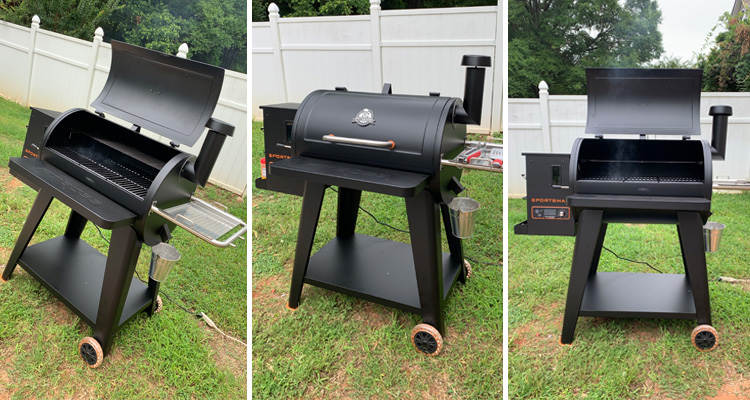
Pit Boss is well known for selling affordable pellet grills that hit the right balance between features and value for money.
The 820 gives you a decent grill size, great quality grill grates, built-in shelving, spice rack and bottle opener, and easy pellet clean-up.
Some of those features are often missing from significantly more expensive grills.
You don’t get any WiFi or app connectivity, so forget about controlling your grill from your phone.
You also get a good searing solution with Pit Boss‘s slide plate flame broiler.
9. A unique design with a small footprint – Grilla Grills Alpha Connect
Grilla have developed a cult following in recent years for producing reasonably priced grills with unique designs.
This is one of the most eye-catching grills we’ve tested, with the sliding door and the branded glass window to the fire pot which creates some nice ambiance at night.
This is a direct-to-consumer brand, so you won’t find these grills in the big box stores.
With 488 square inches of cooking space, this is one of the smallest grills we’ve tested, but the tall design makes it a great choice if you are limited for space.
What we like:
- Build Quality – Double-wall insulation for stable temps and everything feels heavy-duty.
- Smoke Flavor – We noticed a higher smoke output compared to other pellet grills.
- Small footprint – This grill can slot into spaces that other grills can’t.
What we don’t like:
- Side tray location – Difficult to use located towards the back of the grill
10. Entry Level Traeger – Traeger Pro 575 Wood Pellet Grill
The Traeger Pro is easily the top-selling wood pellet grill in the world.
It doesn’t have all the bells and whistles of the more expensive Ironwood and Timberline models, but for under $1000, you get a grill so easy to use that anyone can cook barbecue on it.
You can choose the Pro with either 575 or 780 square inches of cooking space, and both sizes come in either black or bronze (#team black).
The larger model will cost you an additional $200, so think about how many people you need to cook for, and this could be an area where you can save some money.
The Pro comes with WiFi for remote control and monitoring of your grill.
You get one temperature probe to monitor your food temperature from the grill controller or the Traeger app. There’s even a smartwatch app, so you can check your temps by glancing at your wrist.
The D2 direct drive uses a brushless DC motor to achieve higher torque at lower RPM. Or, in plain English, the motor can turn the pellet auger faster, which lets you get more fuel into the firepot for faster and hotter cooking.
These features used to only come with the top-of-the-range Timberline series, making the Pro a great buy, in our opinion.
You don’t get the built-in pellet sensor included on the higher-spec models, but now you can purchase this as an add-on. It’s great to check your pellet levels from the app, especially during an overnight brisket cook.
Food cooked on the Pro has a subtle, smokey flavor that most people will enjoy. It’s definitely not overpowering. If you like your food a little more smokey keep reading because we have some options that might be better for you.
What we like:
- Highly accurate D2 PID controller – The Traeger Pro controller uses a variable speed fan that can speed up or slow down to reach and hold a more exact temperature. You can set the temperature within 5°F increments.
- WiFi connectivity – The so-called WiFIRE technology is quite clever, allowing you to control temperatures and monitor your food from anywhere via your smartphone.
What we don’t like:
- Crucial accessories cost extra – You’ll have to fork out extra for the grill cover & folding shelf accessories, which some companies will throw in for free.
- Subtle smoke flavor – This could be a pro or con, depending on your preferences.
11. A large mid-range option – recteq Flagship 1100
We could definitely include this REC TEC grill with our top choices above.
With the Flagship 1100, recteq has combined the precision craftsmanship and build quality they are known for with some modern upgrades, including WiFi connectivity, dual meat probes to monitor the internal temperature of your meat, and an improved PID controller.
The controller lets you adjust the temperature in 5°F increments, which is a level of control you don’t see on some of the cheaper pellet grills out there.
It’s not a budget grill, although it does compare well with the more expensive Ironwood and Timberline series by Traeger.
The majority of the grill is made of 304 stainless steel. You also get a huge 40lb pellet hopper capacity for up to 40 hours of continuous cooking and rollerblade-style wheels to easily move the grill around.
Finally, you get those signature recteq bull horn handles, which on their own make this grill worth considering, in our opinion!
Who pellet smokers are best suited for
Even an entry-level pellet smoker will set you back more than a charcoal or gas grill. But for a little bit extra upfront, you’ll enjoy the simplicity and versatility that have made pellet smokers take over patios around the country.
Prices for pellet grills start at around $400 and can run up to $2,000-$3,000+ for high-end or made-in-the-USA models. When you can get an excellent charcoal smoker like the Weber Smokey Mountain for around $300, you may be asking yourself why you would want to buy a pellet grill.
It only takes two words to sum up the benefits of cooking with a pellet smoker. “Convenience” and “versatility”.
Get used to throwing a brisket on the pellet grill, setting the temperature, and then just going about your day (or sleep through the night) without a worry.
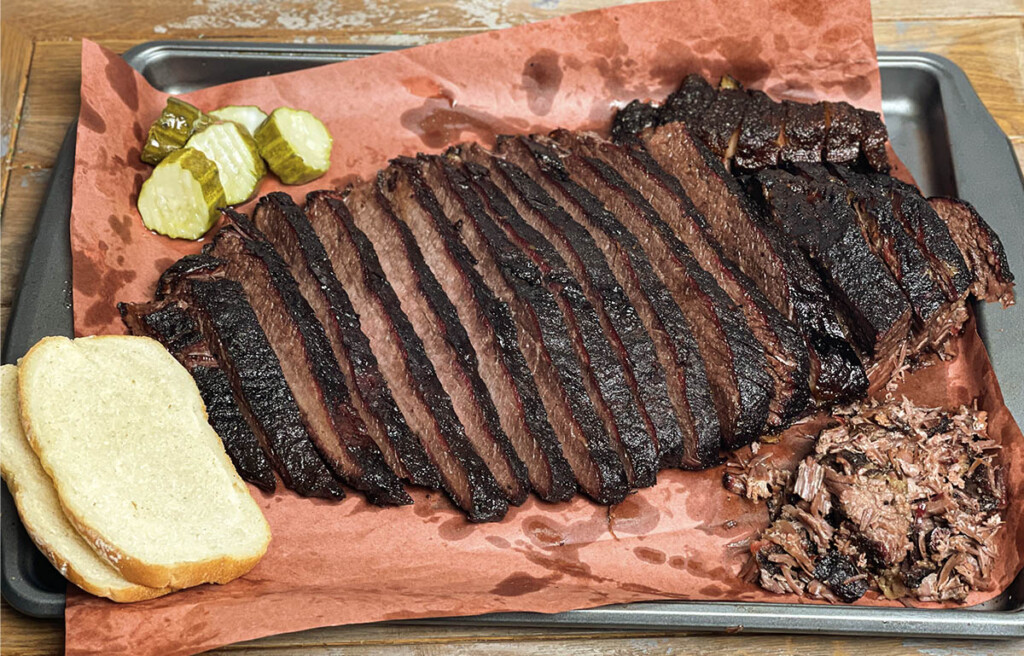
Our pellet grill brisket recipe proves a pellet grill is more than capable
Because pellet smokers run off electricity they can also be a great choice if you live in a condo or are unlucky enough to have restrictions on burning charcoal or wood.
Check out our list of pellet grill recipes for more inspiration of what you can cook.
How pellet smokers work
As the name implies, pellet grills work by burning cylindrical wooden pellets. A typical setup will include a hopper on the side where you add the pellets.
Don’t be confused if you see the “pellet grill” and “pellet smoker” used interchangeably. They refer to the same thing.
When you plug the grill in and set the heat on a digital controller, the pellets start getting pushed through and turned into heat and smoke.
Meathead explains in more detail how this process works over at amazingribs.com.
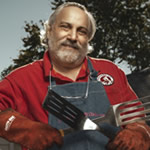
Meathead Goldwyn, Pellet Smokers Buying Guide
Central to all pellet cookers is a digital controller similar to the controllers on modern indoor ovens. You select a temp you want, and there is an LED display that tells you the actual temp.
Pellet cookers usually have an auger or another feed mechanism that pushes the pellets into a burn pot typically about the size of a beer can ripped in half. An igniter rod sits in the bottom of the pot and when you turn on the grill it glows like the element on an electric stove.
As the pellets ignite, a fan blows to feed them oxygen, and the igniter shuts off.
The controller is one of the most important parts of a pellet smoker. It’s the computer that regulates the temperature in your pellet cooker throughout the cook.
These days, most controllers are PID and use complex algorithms to keep temperatures accurate to within a few degrees. The pellet feed is constantly adjusted to maintain the correct temperature.
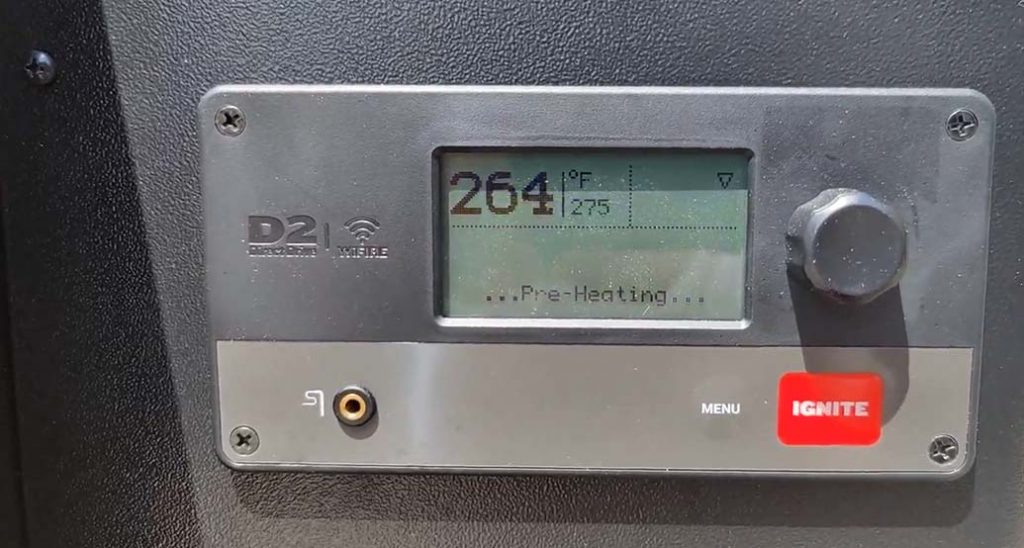
The D2 controller you get with a Traeger Pro is a PID controller.
The level of technology inside a typical pellet smoker makes a gas or charcoal grill look primitive.
What to think about before buying a pellet grill
Plan how much cooking real estate you need
Ask yourself a couple of questions. How many people will I be cooking for? Do I plan on cooking large cuts or even a whole pig?
Remember that bigger doesn’t always mean better. A huge pellet smoker will burn more pellets per hour than a smaller model.
A standout feature of pellet smokers is that the temperature is relatively even across the cooking area. As a result, there should be no temperature difference between the top and bottom rack while cooking.
Keeping this in mind, let’s discuss the difference between the primary and total cooking areas.
The primary cooking area refers to the area on the main cooking plate. The total cooking area takes into consideration secondary racks.
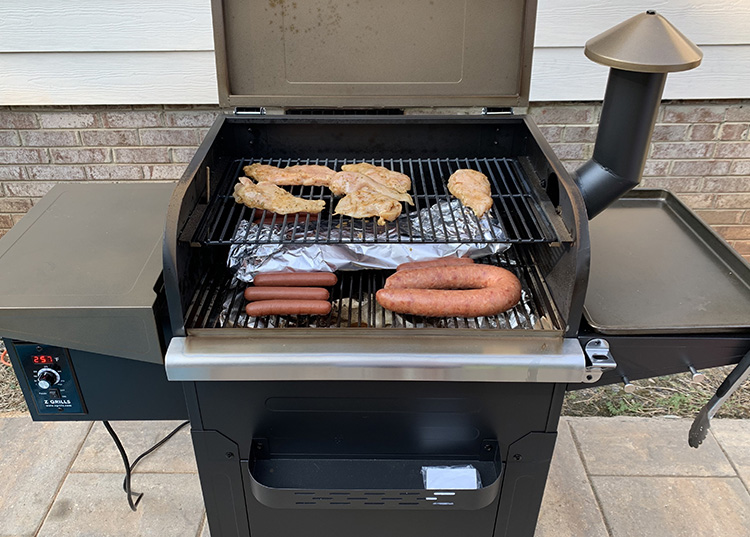
Therefore, a large pellet grill with a primary cooking area of 500 square inches might be of less use to you than a smaller cooker with a total cooking area that includes a 450 square inch primary rack and a 125 square inch secondary rack.
If you couldn’t be bothered doing the math, that’s 575 square inches of total cooking space.
The bottom line is this – take stock of what you need, and don’t be fooled into thinking that bigger is better.
Which features and capabilities are important
Wood pellet grills can come with a whole bunch of bells and whistles. Some features you should think about include:
- WiFi capability: With WiFi connectivity, you can monitor and control the temperature of your grill from just about anywhere, as long as you have an Internet connection.
- Meat probes: Different models allow you to connect meat probes so you can display the temperature on the screen of your cooker (or in the app).
- Grilling options: In the past, a drawback of pellet grills was their lack of grilling capability. Some manufacturers have made grilling possible by removing part of the diffuser plate or providing a dedicated grilling area within the cooker.
- Pellet removal: Most brands recommend removing pellets between cooks. Some models make this easy with a chute to remove unused pellets. Others you’ll need to vacuum out.
- Cart Design: Some pellet grills come with closed cart designs which are helpful for storing pellets and accessories.
- Add-ons: Manufacturers often offer a variety of add-ons. Check what features come standard and what are add-ons at extra cost. Some add-ons are offered by companies independent of the manufacturer. If a feature is essential to you but not a standard feature of your particular cooker, make sure it is available as an add-on before buying it.
Durability and Construction Material
Don’t be fooled by an attractive pellet grill exterior. Even if there is plenty of stainless steel on the outside, the manufacturer may have cut corners and used cheap materials that will rust on the inside.
The components of your pellet grill that matter the most are the fire pot, flame deflector, drip pan, and grates. If these components are made of high grade stainless steel, you have a cooker that will last you a lifetime.

The Yoder YS640s shines when it comes to construction quality.
If you’re looking at a grill made with powder-coated steel, make sure that it is a very high-quality coating. As soon as the paint blisters and chips, your cooker will start to rust and these components will deteriorate.
It is also worth noting that a pellet smoker made of high quality materials will perform better. High quality materials will retain heat, ensure more efficient pellet consumption, and maintain temperature better in the cold weather.
Ease of clean up
Pellet grills require regular cleanup as the ash from burnt pellets builds up around the burn pot and under the heat deflector.
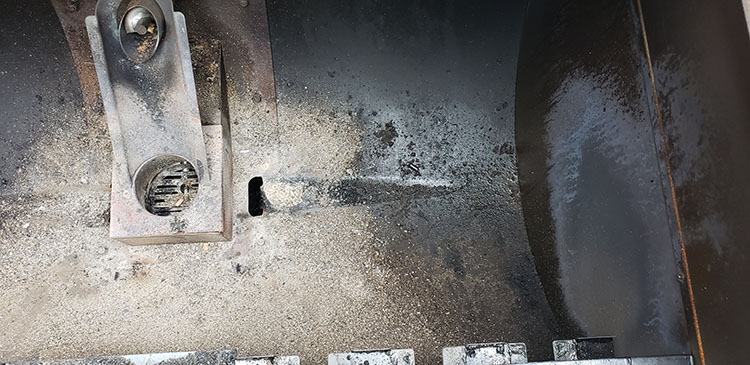
Most models are fairly easy to clean with a shop vac. You’ll need to remove the grill grates and remove the deflector plate.
Some models, like the Camp Chef Woodwind have an easy way to clean out the ash from the burn pot without taking apart the whole grill.
You can simply pull a sliding rod that relaces a catch pot for quick disposal. You’ll still need to take the grill apart to get rid of the ash from the sides but you don’t have to do that nearly as often.
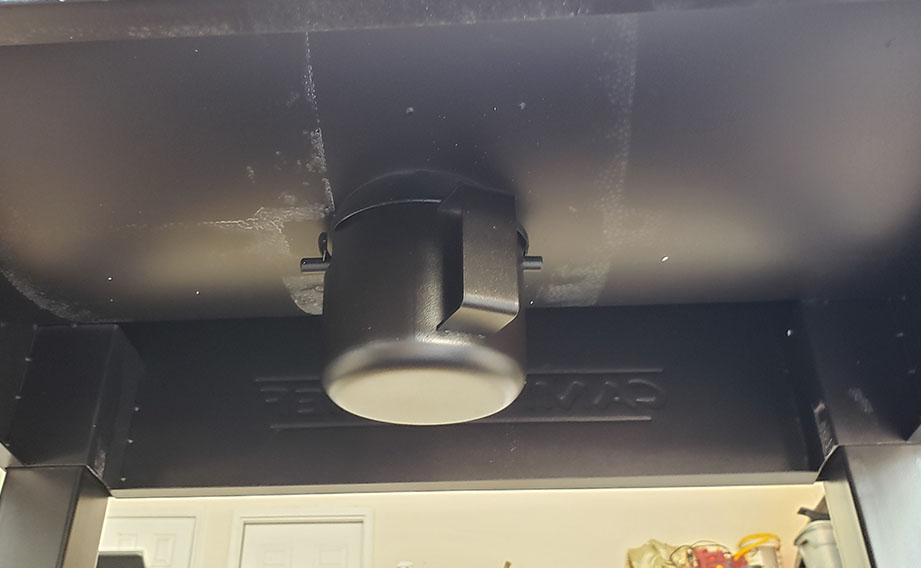
If you don’t clean out the burn pot every cook you run the risk of ash buildup causing problems with ignition in the future.
Size of the hopper
The hopper on your pellet cooker is a container that stores wood pellets ready for the auger to take them to the fire-pot. Therefore, the size of your hopper essentially dictates how long your cooks run without you needing to refill.
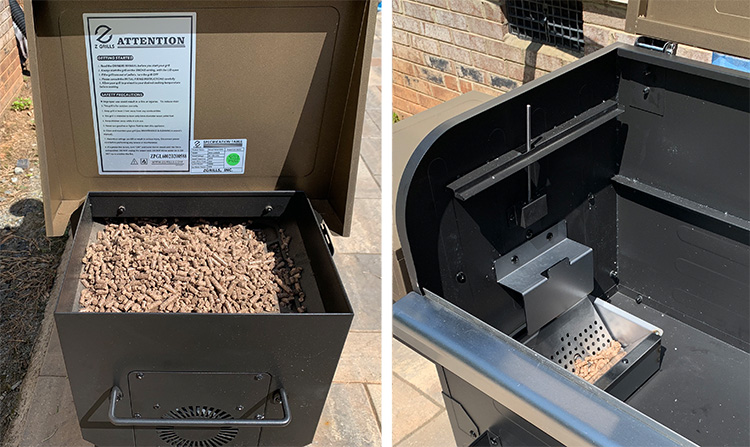
As a guide, a pellet grill with a 40-pound hopper will give you around 40 hours of cooking time at standard smoking temperatures. Considering some cooks take around 20 hours, an 18 pound hopper, for example, is going to be problematic.
And remember, if you live in a colder climate, your cooker will use even more fuel to bring the smoker up to and maintain temperature.
It’s a good idea to always store a few bags of pellets spare in a cool dry place. A pellet bucket like this one from Oklahoma Joe’s is nice, and comes with a mesh filter to separate the wood dust from the pellets.
Pellet Consumption
Nobody likes a pellet hog, that is, a pellet burner that chews through excessive pellets.
If your pellet cooker is too thin, heat will be lost through the body of the cooker. It will use a lot of pellets just to maintain the temperature.
If the metal is too thick, you will also use a lot of pellets. The walls of a thick-bodied smoker act as a “heat sink”. Heat is taken away from the cooking area and stored in the walls of the cooker. So, it will take a lot of pellets to get the cooking area up to the desired temperature. While thick walls are desirable for some types of cookers, they are not required in pellet smokers.
Do some research and find out how many pounds of pellets per hour the smoker burns.
We did some testing on a few different pellet grill models and came up with these figures:
Average hourly pellet consumption
Give our guide on how long pellets last a read to learn more.
Length of warranty
There are some fairly high tech components in pellet smokers. There are also moving parts, such as the auger. This means that there are parts of your cooker that may break, and that you may not be able to fix yourself.
Make sure you are clear about exactly how long your warranty is, what it will cover, what would void it, and where you would need to take your smoker for any repairs under warranty.
Warranties vary between manufacturers, so don’t be afraid to ask lots of questions.
Beware of gimmicks
There is a fine line between useful technology and tacky gimmicks. With increasing competition among manufacturers, companies are keen to stand out above the rest.
That is not to say that all features are simply gimmicks and should be dismissed as such. Ultimately, you have to think about whether the features on the pellet smoker are of actual use to you.
Some find the slide and sear system many Camp Chef and Pit Boss grills use incredibly useful, while others would rather have a dedicated grill for searing and use their pellet grill for low and slow.
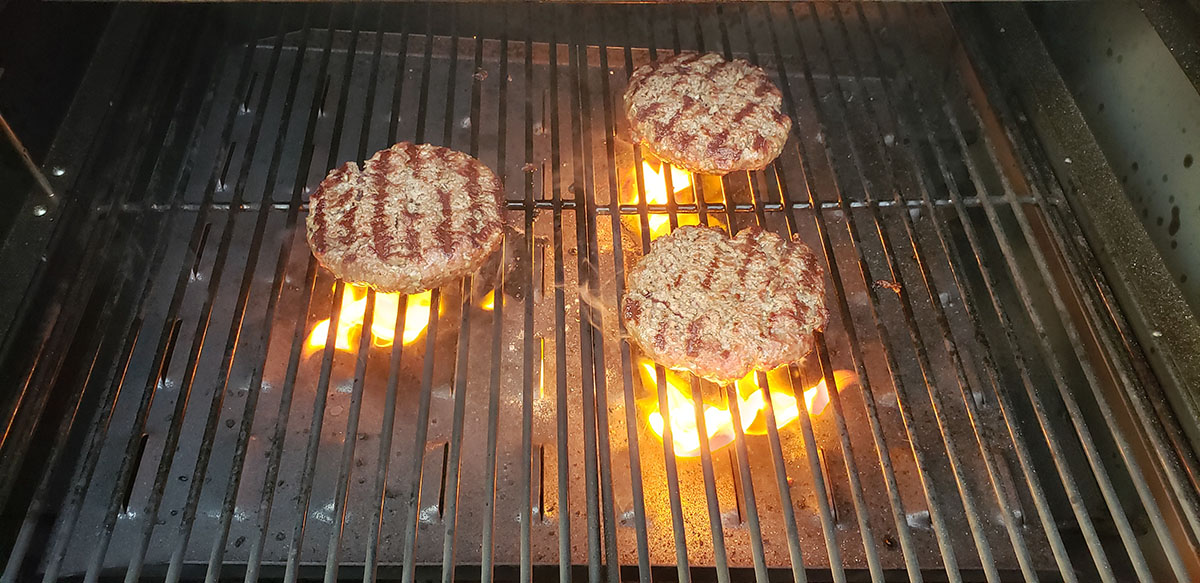
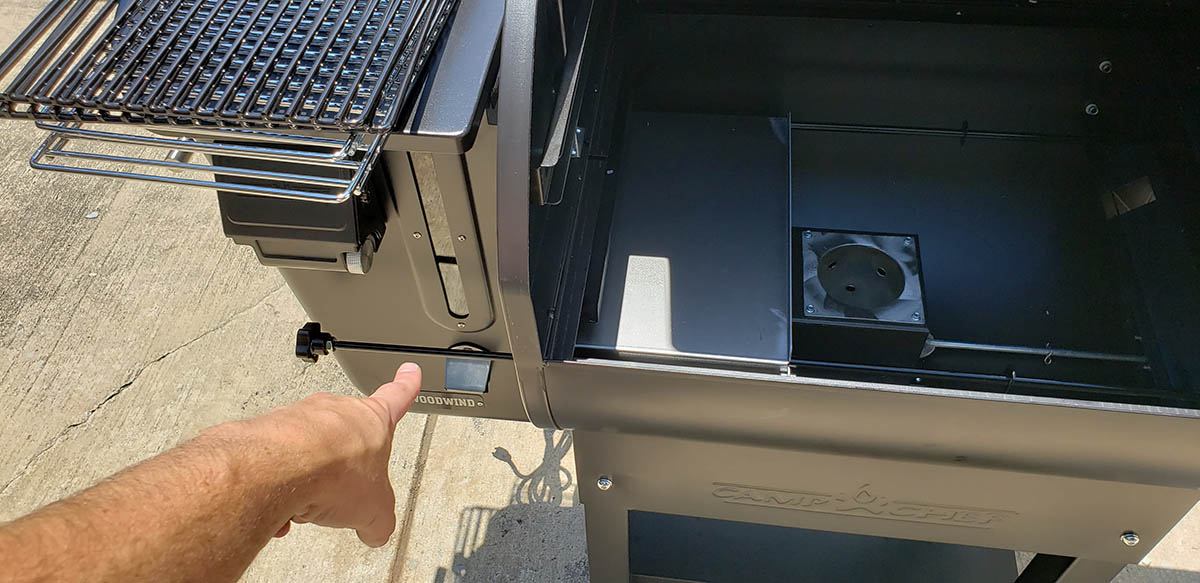
If the feature is something you would consider helpful, is it included at the expense of other, more important things, such as pellet usage or durability?
For example, consider the inclusion of WiFi, or other remote control features.
However, if you live in a cold climate and it is freezing outside, the ability to control your cook from inside your warm home may well be an appealing feature. If that’s the case then grill with good WiFi connectivity and app design like the Traeger Pro might be right up your alley.
Customer Service
As usual, there’s some good advice over at Amazing Ribs about the importance of customer service, especially for pellet grills.

Meathead Goldwyn, Pellet Smokers Buying Guide
In 2008 there were only two consumer pellet grill manufacturers. Today there are more than a dozen. The market for these relatively expensive devices is small but growing fast. Not all of these small manufacturers will survive.
Forget the warranty and ask “When it breaks will the manufacturer still be in business?” They do not have repair shops near you. When it breaks will they be able to diagnose the problem over the phone?
They may be able to figure it out, but then you have to buy the replacement parts and do the repair work yourself. Are you up to the task?
Buying from a larger, established company means there is likely to be a dedicated customer service team. It also means the company is likely to still be around a few years down the track when you may need their assistance.
On the flip side, a smaller company may be able to offer more personal and reliable service, and the people you contact are likely to be very well acquainted with your model of pellet grill.
You won’t find out how the manufacturer stacks up when it comes to customer service unless you ask questions, and get straight answers.
Price
One word of caution – don’t confuse a cheap cooker with a cooker that is good value.
A cheap cooker may save you up front, but if it starts to rust, components break down within a few short years, you don’t have a good warranty and the customer service is not up to par, you will be spending more money in the long run.
On the other hand, if you purchase a cooker that has all the bells and whistles, but you never use them, you will have wasted your hard earned cash when a more basic cooker, that cost less, would likely have done the trick.
Before forking out cash, be sure to review all of the points above. Check out what’s available in your area, and ask lots of questions. Then, all that is left to do is enjoy your new cooker!
Given the huge variation in price, it is important to know what you are looking for when purchasing a pellet smoker. Running through a bit of a checklist is certainly a great way to make sure you haven’t missed anything.
The pros and cons of buying a pellet smoker
As we’ve mentioned above, most people end up choosing a pellet style smoker because of the convenience and versatility. Like an electric smoker, you get:
- Set it and forget it smoking – Just make sure the hopper is full of pellets and set your desired temperature and there isn’t much else you need to worry about.
- Simple temperature control – Most pellet smokers let you dial in the temperature to within five degrees, and the unit does a good job of maintaining a stable temperature.
There are also a few advantages unique to cooking with a pellet smoker:
- Super fuel efficient – Pellet smokers are similar to your home oven, with a super efficient convection fan, so you spend a lot less in pellets than charcoal.
- Less effort cleaning up – Charcoal smokers can make a bit of a mess every time you cook. With a pellet grill you might have to clear out the firepot every now and again but it’s rare (think once every 60 usages).
Steven Raichlen has an excellent breakdown of the various pros and cons of pellet grills that you may want to check out.

Steven Raichlen, New Kid on the Block: Pellet Grills
Pellet grills are versatile. You can barbecue, smoke, roast, grill (sort of–more on that below), and even bake or braise in a pellet grill. At BBQ University, we have used them to cook everything from crisp chicken wings to braised short ribs to smoked pork chile verde and crème brulee.
Like gas grills, pellet grills preheat fast (10 to 15 minutes). The design discourages flare-ups.
Some pellet grills allow you to regulate temperatures in 5-degree increments, giving you pinpoint heat control. A thermostat in the cooking chamber sends precise signals to the controller and regulates pellet delivery.
Pellet smokers aren’t without their issues though. Some potential problems include:
- Costs more to get a reliable unit compared to other types of smoker – You can pick up excellent charcoal, gas or electric smokers between $200-$500 while a good pellet will run you between $400-$1000+
- You can’t cook as hot or generate as much smoke – You won’t get quite as good a sear as you could with a charcoal grill. And you won’t get that dominate smokey flavor you would get with an offset stick burning smoker.
- You will need to plug the grill into electricity – This can limit where you set it up, and stop you from taking it away camping (unless you also have a generator).
- Need to keep an emergency pellet stockpile – If you’re grilling with propane or charcoal and run out half way through a 12 hour cook you can easily nip down to the store. But getting your favorite brand of pellets may require an Amazon order, or a trip to a more specialised store.
Pellet smokers aren’t for everyone, but if none of those sound like deal breakers then you may well be calling yourself a ‘pellethead’ any day now.
Pellet Grill frequently asked questions
What are the best affordable pellet grills?
Luckily, the days when you had to splash out top dollar for a new pellet grill are behind us. Brands like Pit Boss, Z Grills, and Green Mountain Grills all produce a range of affordable options.
If you want a full-featured grill that compares with Traeger and Camp Chef, the Z Grills 7002C2E is great value. If you want something sub $500, then Z Grills 450B fits the bill, although you’ll give up a little size.
Are pellet grills worth it?
Whether or not you get value out of a pellet grill depends entirely on what you are looking for in a grill.
If you primarily plan on smoking and want something easy to run, then a pellet grill is a great choice. While some pellet grills struggle to grill well, more and more manufacturers are adding grilling options, so this isn’t necessarily a deal breaker any more.
If you want something more hands-on and interactive, then you might find the simplicity of a pellet grill a tad boring. If that sounds like you, do yourself a favor and look into a charcoal or wood burning smoker.
Are Traegers worth it?
As the largest pellet grill brand, Traeger attracts a lot of attention. Both positive and negative.
A large part of the negative opinion seems to have come from a rough period Traeger went through in the mid 2010s when the quality of their grills suffered, and they moved manufacturing to China.
Traeger seems to have righted the ship since then, and the grills they sell today are very competitive.
I’ve owned a Pro 575 since 2020, and my experience has been overwhelmingly positive. This is the value sweet spot, and once you step up to the Ironwood and Timberline series you are definitely paying for the brand.
Wrapping it up
Pellet smokers are fast proving to be more than just a fad.
While some old timers claim they’re little more than an ‘expensive oven’ for more amateur to enthusiast smokers the convenience of use and quality of the food they produce is hard to beat.
The pellet grill market is incredibly competitive, so there isn’t much room between our top picks.
Hopefully, this guide has helped you understand a little bit more about the pros and cons of cooking with a pellet grill, and helped you pick out the right model for your budget and needs.
Once you’ve pulled the trigger, check out our guide with 21 Pellet Grill Tips & Tricks to Help You Master Your Grill.
Happy smoking!
 Backyard GrillingWeekend WarriorsAdvice from DadBeard GroomingTV Shows for Guys4x4 Off-Road CarsMens FashionSports NewsAncient Archeology World NewsPrivacy PolicyTerms And Conditions
Backyard GrillingWeekend WarriorsAdvice from DadBeard GroomingTV Shows for Guys4x4 Off-Road CarsMens FashionSports NewsAncient Archeology World NewsPrivacy PolicyTerms And Conditions
